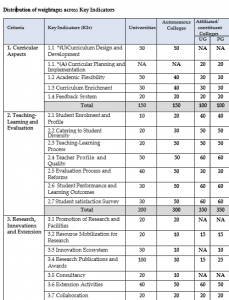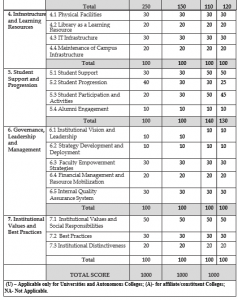
Higher education plays an extremely important role in the overall development of a society and nation at large. Along with contributing to the nation’s long-term economic development, it plays a significant role in promoting human and societal wellbeing and in developing a nation into a democratic, just, socially conscious, cultured, and humane entity that upholds liberty, equality, and justice for all. The role of higher education has become critical in preventing the creation of a global useless class amid the volatility, uncertainty, complexity and ambiguity (VUCA) in the 21st century.
In view of the requirements of the 21st century, higher education is key to creating a vibrant, socially engaged, cooperative, happy, cohesive, cultured, productive, innovative, progressive, and prosperous nation. The committee on the National Education Policy 2020 (NEP 2020) says, “Higher education must enable an individual to study one or more specialised areas of interest at a deep level, and also develop character, ethical and constitutional values, intellectual curiosity, scientific temper, creativity, spirit of service, and 21st century capabilities across a range of disciplines including sciences, social sciences, arts, humanities, languages, as well as professional, technical, and vocational subjects.”
The most pressing questions for higher education institutions are how to stimulate an academic environment for quality teaching and learning, and how to encourage self-evolution, accountability, autonomy, research, and innovation. Simply designing curriculums without assessing quality will create a half-finished product.
To address these concerns, the NAAC (National Assessment And Accreditation Council) was established as an autonomous body under Section 12-CCC of the UGC Act 1956 and registered at Bangalore on September 16, 1994 under the Karnataka Societies Registration Act, 1960 and the Karnataka Societies Registration Rules, 1961 to conduct quality assessment and accreditation of higher educational institutes.
READ I Budget 2022 misses the point on education, innovation
Benefits of NAAC assessment
NAAC assesses institutions based on their compliance to pre-stated quality standards in terms of educational processes and outcomes, curriculum coverage, teaching-learning processes, faculty, research, infrastructure, students’ progression, learning resources, organisation, governance, financial wellbeing, and student services. Its operations are overseen by a general council and an executive committee (EC) drawn from senior academics and educational administrators from universities, colleges, and professional bodies, as well as representatives from organisations like the University Grants Commission and the Union ministry of education.
The NAAC employs a globally recognised and accepted methodology that consists of five stages: identifying pre-determined assessment criteria; preparation and submission of a self-study report (SRR); data validation and verification (DVV); site visit of peer team to validate the report and recommend the assessment outcome to the NAAC; and the final decision by the NAAC Executive Committee.
Initially, 10 parameters which encompass all functions of a higher education institution – goals and objectives; curriculum design and evaluation; teaching-learning and evaluation; research and publications; consultation and extension activities; management and organisation; infrastructure resources; support services; feedback from students as well as counselling; and the generation and management of financial resources – were used as the foundation for evaluation.
Over time, changes were made in the parameters to cope with changes in the dynamics of teaching, learning, and overall functioning of the institutions. Currently, seven criteria with 34 key indicators are used for overall quality assessment and accreditation. (Table 1)


These seven criteria and 34 key indicators do not guarantee quality. However, they are an excellent means of ensuring quality in teaching, learning, management, and governance. Quality assessment is a complicated issue. It entails much more than simply applying predetermined criteria to arrive at simple and straightforward solutions. In developing countries like India, there are several factors ranging from financial constraints to sociological contexts that dramatically affect the quality of higher education.
By using an external quality assurance (EQA) mechanism, one cannot address all of the factors and provide solutions to all of the problems associated with the quality of higher education. At the same time, one cannot deny the fact that quality assessment is useful for providing an outcome that institutions and other stakeholders can use while identifying their priorities and decision-making process.
The NAAC process has had a remarkable multiplicity of effects on all higher education stakeholders. Institutions have finally realised that ensuring quality in the delivery of teaching and learning is their responsibility. Management/administrators at the institutional level have implemented numerous changes such as the formation of various societies, cells, and committees as well as feedback mechanisms. Most institutions have seen the implementation of need-based programmes which has increased the number of programme options.
To meet the growing demands from students, many institutions established their own certificate and diploma programmes other than the mandated curriculum of degree programmes. Many autonomous and affiliate institutions have given enough flexibility to students to design their own curriculum using choice-based credit system (CBCS). Institutions have allowed students to choose what is best for them, based on their preferences, interests, needs, and abilities.
READ I Digital education push welcome, but not at the cost of institutions
Dealing with data on higher education
Across institutions, there is a clear improvement in teaching and learning strategies. Teaching-learning and evaluation receive the highest weightage in the NAAC assessment. It encourages the institution to go beyond the routine examination-oriented outcomes. As a result, institutions are investing in improved teaching methods such as the use of educational technology, projects and student seminars, the provision of computer skills, the promotion of co-curricular activities, and the incorporation of community orientation through various cells and societies.
One of the assessment criteria is research, consultancy, and extension, which has fostered a research culture even in colleges that were previously solely focused on teaching. Despite the fact that the weightage assigned to this criterion is the lowest for affiliated colleges, it has increased encouragement for faculty research at all levels, including affiliated undergraduate colleges.
Aside from improved student services, increased interdepartmental interactions, and staff and faculty training and development, the NAAC assessment process has also improved documentation skills across various societies, cells, committees, departments, and institutions. Institutions are putting a lot of emphasis on keeping records with proof of student progression, alumni profiles, placement services, and so on. Faculties have also developed a practise of keeping teaching diaries and documenting their academic contributions.
But does this imply that NAAC is an infallible mechanism for ensuring overall quality of higher education institutions? Can’t we use traditional data such as educational and general operating expenditure per student, research income generated, annual endowment growth, class size, student-faculty ratio, library holdings, student success rate, and student employment rate to directly and explicitly address the issue of quality in higher education? Are we on the verge of such a teaching-learning system in which various types of data and their documentation take precedence over the well-being of students and teachers?
Traditional data is important and useful. It can be used simply for quality assessment in the presence of authentic and appropriate supporting documents. However, given the complexity and capabilities of the twenty-first century across disciplines, institutions’ responsibility and accountability, global competitiveness, and, most importantly, regulators’ assurance of quality teaching-learning, management, and governance of HEI, these indicators are not sufficient. We are currently living in a VUCA world, and no one knows what skillsets will be required 10 years from now.
According to a Dell Technologies study, 85% of the jobs that Generation Z and Alpha will be doing in 2030 have not yet been invented. Another intriguing finding from a recently released World Economic Forum (WEF) report is that 65% of today’s primary school children will work in jobs that do not yet exist. What should be taught at a time when Al and robots will be used extensively at the workplace? What are the skills that will ensure that our children will; not be replaced by robots?
This is only the beginning of the technological revolution, the enormous impact yet to be seen, wrote Satya Nadella, executive chairman and CEO of Microsoft in his book ‘Hit Refresh’. In line with this argument, Sundar Pichai (CEO, Alphabet Inc.) stated at the 2020 WEF discussion table that the biggest risk will be failing to grasp AI’s potential for good.
Given the limitations of India’s higher education institutions, their IT infrastructure, institution assessment, and accreditation should be broad enough to encompass all dimensions and dynamics of teaching-learning, management, and governance. These can be assessed using qualitative and quantitative indicators.
The current base for assessment of NAAC should include issues like national development, global competencies, inculcating value system (ethics, culture, character etc.), data on entrepreneurial development, data on student and teachers’ mental and physical wellbeing, other than student satisfaction surveys. Some affiliate colleges do not offer multiple courses which is an impediment for the college in getting better ratings and ranking. Therefore, NAAC should also assess and accredit departments and programmes offered by institutions.
As for the massive data and documentation requirements of the process, regulatory agencies should provide adequate funding to the institutions for IT infrastructure so that data and documentation can be processed easily and efficiently. “The theories we construct, the hypotheses we test and the beliefs we have, are all shaped by our system of metrics,” says Stiglitz, Sen and Fitoussi. NAAC and other regulators should be concerned about the effort institutions are putting in for data generation and documentation as well as the benefits from the overall quality assessment.
(Shashank Vikram Pratap Singh is Assistant Professor, Shri Ram College of Commerce, University of Delhi. Views are personal.)
